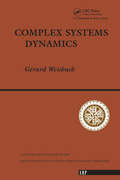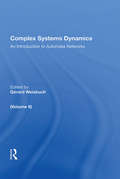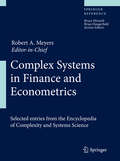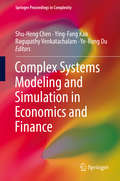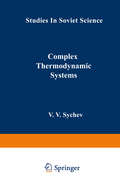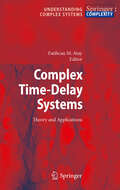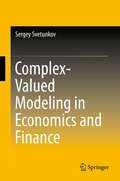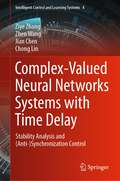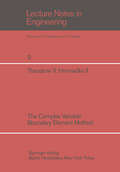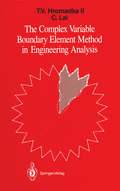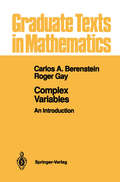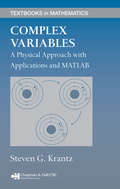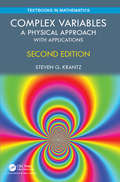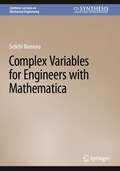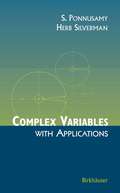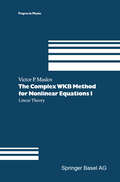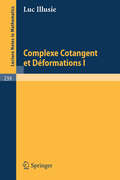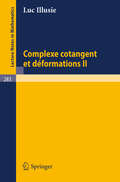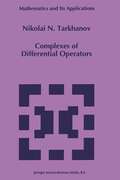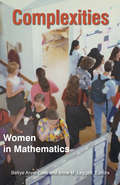- Table View
- List View
Complex Systems Dynamics
by Gerard WeisbuchFirst Published in 2018. Routledge is an imprint of Taylor & Francis, an Informa company.
Complex Systems Dynamics (volume Ii)
by Gerard WeisbuchThis book provides an accessible introduction to complex systems viewed as networks of automata, using primarily examples drawn from the physics of disordered systems, neural networks, and the origins of life. It is helpful for readers with a university education in science or engineering.
Complex Systems Dynamics (volume Ii)
by Gerard WeisbuchThis book provides an accessible introduction to complex systems viewed as networks of automata, using primarily examples drawn from the physics of disordered systems, neural networks, and the origins of life. It is helpful for readers with a university education in science or engineering.
Complex Systems in Biomedicine
by A. Quarteroni L. Formaggia A. VenezianiMathematicalmodelingofhumanphysiopathologyisatremendouslyambitioustask. It encompasses the modeling of most diverse compartments such as the cardiovas- lar,respiratory,skeletalandnervoussystems,aswellasthemechanicalandbioch- ical interaction between blood ?ow and arterial walls, and electrocardiac processes and electric conduction in biological tissues. Mathematical models can be set up to simulate both vasculogenesis (the aggregation and organization of endothelial cells dispersed in a given environment) and angiogenesis (the formation of new vessels sprouting from an existing vessel) that are relevant to the formation of vascular networks, and in particular to the description of tumor growth. The integration of models aimed at simulating the cooperation and interrelation of different systems is an even more dif?cult task. It calls for the setting up of, for instance, interaction models for the integrated cardio-vascular system and the interplay between the central circulation and peripheral compartments, models for the mid-to-long range cardiovascular adjustments to pathological conditions (e.g., to account for surgical interventions, congenital malformations, or tumor growth), models for integration among circulation, tissue perfusion, biochemical and thermal regulation, models for parameter identi?cation and sensitivity analysis to parameter changes or data uncertainty – and many others.
Complex Systems Modeling and Simulation in Economics and Finance (Springer Proceedings in Complexity)
by Shu-Heng Chen Ying-Fang Kao Ragupathy Venkatachalam Ye-Rong DuThis title brings together frontier research on complex economic systems, heterogeneous interacting agents, bounded rationality, and nonlinear dynamics in economics. The book contains the proceedings of the CEF2015 (21st Computing in Economics in Finance), held 20-22 June 2015 in Taipei, Taiwan, and addresses some of the important driving forces for various emergent properties in economies, when viewed as complex systems. The breakthroughs reported in this book are a result of an interdisciplinary approach and simulation remains the unifying theme for these papers as they deal with a wide range of topics in economics. The text is a valuable addition to the efforts in promoting the complex systems view in economic science. The computational experiments reported in the book are both transparent and replicable.Complex System Modeling and Simulation in Economics and Finance is useful for graduate courses of complex systems, with particular focus on economics and finance. At the same time it serves as a good overview for researchers who are interested in the topic.
Complex Thermodynamic Systems (Studies in Soviet Science)
by V. V. SychevThermodynamic methods of analysis have in recent years found ever-growing extensions in diverse regions of modern tech nology. The object of the present book is to apply these methods to the description of materials of varying physical properties. I hope the book will illustrate the wide variety and usefulness of thermodynamics which was well described by Albert Einstein: "A theory is the more impressive the greater the simplicity of its premises is, the more different kinds of things it relates, and the more extended is its area of applicability. Therefore the deep impression which classical thermodynamics made upon me." The work of the American thermodynamic school is well known in the Soviet Union, and thus it is a great pleasure to offer this book to American readers. V. V. Sychev v Preface At the present time, when a number of new areas of tech nology are rapidly evolving, it is difficult to present a modern course in technical thermodynamics without developing such sub jects as the thermodynamics of insulators, magnets, and super conductors, or without treating the features of thermodynamic systems located in a gravitational field and in conditions of weight lessness, etc. In fact the limited coverage of technical thermody namics in the usual textbooks and school equipment as a rule prevents the authors from giving any detailed discussion of these important problems. I therefore resolved to treat these problems in a separate text. I discussed the concept of this book with my teachers V. A.
Complex Time-Delay Systems: Theory and Applications (Understanding Complex Systems)
by Fatihcan M. AtayOne of the major contemporary challenges in both physical and social sciences is modeling, analyzing, and understanding the self-organization, evolution, behavior, and eventual decay of complex dynamical systems ranging from cell assemblies to the human brain to animal societies. The multi-faceted problems in this domain require a wide range of methods from various scienti?c disciplines. There is no question that the inclusion of time delays in complex system models considerably enriches the challenges presented by the problems. Although this inclusion often becomes inevitable as real-world applications demand more and more realistic m- els, the role of time delays in the context of complex systems so far has not attracted the interest it deserves. The present volume is an attempt toward ?lling this gap. There exist various useful tools for the study of complex time-delay systems. At the forefront is the mathematical theory of delay equations, a relatively mature ?eld in many aspects, which provides some powerful techniques for analytical inquiries, along with some other tools from statistical physics, graph theory, computer science, dynamical systems theory, probability theory, simulation and optimization software, and so on. Nevertheless, the use of these methods requires a certain synergy to address complex systems problems, especially in the presence of time delays.
Complex Tori (Progress in Mathematics #177)
by Herbert Lange Christina BirkenhakeA complex torus is a connected compact complex Lie group. Any complex 9 9 torus is of the form X =
Complex-Valued Modeling in Economics and Finance
by Sergey SvetunkovComplex-Valued Modeling in Economics and Finance outlines the theory, methodology, and techniques behind modeling economic processes using complex variables theory. The theory of complex variables functions is widely used in many scientific fields, since work with complex variables can appropriately describe different complex real-life processes. Many economic indicators and factors reflecting the properties of the same object can be represented in the form of complex variables. By describing the relationship between various indicators using the functions of these variables, new economic and financial models can be created which are often more accurate than the models of real variables. This book pays critical attention to complex variables production in stock market modeling, modeling illegal economy, time series forecasting, complex auto-aggressive models, and economic dynamics modeling. Very little has been published on this topic and its applications within the fields of economics and finance, and this volume appeals to graduate-level students studying economics, academic researchers in economics and finance, and economists.
Complex-Valued Neural Networks Systems with Time Delay: Stability Analysis and (Anti-)Synchronization Control (Intelligent Control and Learning Systems #4)
by Ziye Zhang Zhen Wang Jian Chen Chong LinThis book provides up-to-date developments in the stability analysis and (anti-)synchronization control area for complex-valued neural networks systems with time delay. It brings out the characteristic systematism in them and points out further insight to solve relevant problems. It presents a comprehensive, up-to-date, and detailed treatment of dynamical behaviors including stability analysis and (anti-)synchronization control. The materials included in the book are mainly based on the recent research work carried on by the authors in this domain.The book is a useful reference for all those from senior undergraduates, graduate students, to senior researchers interested in or working with control theory, applied mathematics, system analysis and integration, automation, nonlinear science, computer and other related fields, especially those relevant scientific and technical workers in the research of complex-valued neural network systems, dynamic systems, and intelligent control theory.
The Complex Variable Boundary Element Method (Lecture Notes in Engineering #9)
by T. V. HromadkaThe Complex Variable Boundary Element Method or CVBEM is a generalization of the Cauchy integral formula into a boundary integral equation method or BIEM. This generalization allows an immediate and extremely valuable transfer of the modeling techniques used in real variable boundary integral equation methods (or boundary element methods) to the CVBEM. Consequently, modeling techniques for dissimilar materials, anisotropic materials, and time advancement, can be directly applied without modification to the CVBEM. An extremely useful feature offered by the CVBEM is that the pro duced approximation functions are analytic within the domain enclosed by the problem boundary and, therefore, exactly satisfy the two-dimensional Laplace equation throughout the problem domain. Another feature of the CVBEM is the integrations of the boundary integrals along each boundary element are solved exactly without the need for numerical integration. Additionally, the error analysis of the CVBEM approximation functions is workable by the easy-to-understand concept of relative error. A sophistication of the relative error analysis is the generation of an approximative boundary upon which the CVBEM approximation function exactly solves the boundary conditions of the boundary value problem' (of the Laplace equation), and the goodness of approximation is easily seen as a closeness-of-fit between the approximative and true problem boundaries.
The Complex Variable Boundary Element Method in Engineering Analysis
by Theodore V. Hromadka Chintu LaiThe Complex Variable Boundary Element Method (CVBEM) has emerged as a new and effective modeling method in the field of computational mechanics and hydraulics. The CVBEM is a generalization of the Cauchy integral formula into a boundary integral equation method. The model ing approach by boundary integration, the use of complex variables for two-dimensional potential problems, and the adaptability to now-popular microcomputers are among the factors that make this technique easy to learn, simple to operate, practical for modeling, and efficient in simulating various physical processes. Many of the CVBEM concepts and notions may be derived from the Analytic Function Method (AFM) presented in van der Veer (1978). The AFM served as the starting point for the generalization of the CVBEM theory which was developed during the first author's research engagement (1979 through 1981) at the University of California, Irvine. The growth and expansion of the CVBEM were subsequently nurtured at the U. S. Geological Survey, where keen interest and much activity in numerical modeling and computational mechanics-and-hydraulics are prevalent. Inclusion of the CVBEM research program in Survey's computational-hydraulics projects, brings the modeling researcher more uniform aspects of numerical mathematics in engineering and scientific problems, not to mention its (CVBEM) practicality and usefulness in the hydrologic investigations. This book is intended to introduce the CVBEM to engineers and scientists with its basic theory, underlying mathematics, computer algorithm, error analysis schemes, model adjustment procedures, and application examples.
Complex Variables: An Introduction (Graduate Texts in Mathematics #125)
by Carlos A. Berenstein Roger GayTextbooks, even excellent ones, are a reflection of their times. Form and content of books depend on what the students know already, what they are expected to learn, how the subject matter is regarded in relation to other divisions of mathematics, and even how fashionable the subject matter is. It is thus not surprising that we no longer use such masterpieces as Hurwitz and Courant's Funktionentheorie or Jordan's Cours d'Analyse in our courses. The last two decades have seen a significant change in the techniques used in the theory of functions of one complex variable. The important role played by the inhomogeneous Cauchy-Riemann equation in the current research has led to the reunification, at least in their spirit, of complex analysis in one and in several variables. We say reunification since we think that Weierstrass, Poincare, and others (in contrast to many of our students) did not consider them to be entirely separate subjects. Indeed, not only complex analysis in several variables, but also number theory, harmonic analysis, and other branches of mathematics, both pure and applied, have required a reconsidera tion of analytic continuation, ordinary differential equations in the complex domain, asymptotic analysis, iteration of holomorphic functions, and many other subjects from the classic theory of functions of one complex variable. This ongoing reconsideration led us to think that a textbook incorporating some of these new perspectives and techniques had to be written.
Complex Variables: A Physical Approach with Applications and MATLAB (Textbooks In Mathematics Ser.)
by Steven G. KrantzFrom the algebraic properties of a complete number field, to the analytic properties imposed by the Cauchy integral formula, to the geometric qualities originating from conformality, Complex Variables: A Physical Approach with Applications and MATLAB explores all facets of this subject, with particular emphasis on using theory in practice.T
Complex Variables: A Physical Approach with Applications (Textbooks in Mathematics)
by Steven G. KrantzWeb Copy The idea of complex numbers dates back at least 300 years—to Gauss and Euler, among others. Today complex analysis is a central part of modern analytical thinking. It is used in engineering, physics, mathematics, astrophysics, and many other fields. It provides powerful tools for doing mathematical analysis, and often yields pleasing and unanticipated answers. This book makes the subject of complex analysis accessible to a broad audience. The complex numbers are a somewhat mysterious number system that seems to come out of the blue. It is important for students to see that this is really a very concrete set of objects that has very concrete and meaningful applications. Features: This new edition is a substantial rewrite, focusing on the accessibility, applied, and visual aspect of complex analysis This book has an exceptionally large number of examples and a large number of figures. The topic is presented as a natural outgrowth of the calculus. It is not a new language, or a new way of thinking. Incisive applications appear throughout the book. Partial differential equations are used as a unifying theme.
Complex Variables: A Physical Approach with Applications (Textbooks in Mathematics)
by Steven G. KrantzWeb Copy The idea of complex numbers dates back at least 300 years—to Gauss and Euler, among others. Today complex analysis is a central part of modern analytical thinking. It is used in engineering, physics, mathematics, astrophysics, and many other fields. It provides powerful tools for doing mathematical analysis, and often yields pleasing and unanticipated answers. This book makes the subject of complex analysis accessible to a broad audience. The complex numbers are a somewhat mysterious number system that seems to come out of the blue. It is important for students to see that this is really a very concrete set of objects that has very concrete and meaningful applications. Features: This new edition is a substantial rewrite, focusing on the accessibility, applied, and visual aspect of complex analysis This book has an exceptionally large number of examples and a large number of figures. The topic is presented as a natural outgrowth of the calculus. It is not a new language, or a new way of thinking. Incisive applications appear throughout the book. Partial differential equations are used as a unifying theme.
Complex Variables for Engineers with Mathematica (Synthesis Lectures on Mechanical Engineering)
by Seiichi NomuraComplex variable theory is attractive for engineers as it offers elegant approaches for certain types of differential equations in engineering including heat transfer, solid mechanics, and fluid mechanics. However, a gap exists between books written by mathematicians and books written by engineers in their specific fields. Naturally, mathematicians tend to emphasize rigorousness and consistency while less emphasizing applications. On the other hand, books written by engineers often jump directly to the specific topics assuming that the readers already have sufficient background of complex variables and the pathway from theory to the application is not clearly elucidated. This book closes the gap in the literature. providing a smooth transition from basic theory to the application is accomplished. Although it is not possible to cover all the topics in engineering exhaustively, the readers can at least find the logic of how and why complex variables are effective for some of the engineering problems. Another motivation for writing this book is to demonstrate that the readers can take advantage of a computer algebra system, Mathematica, to facilitate tedious algebra and visualize complex functions so that they can focus on principles instead of spending endless hours on algebra by hand. Unlike numerical tools such as MATLAB and FORTRAN, Mathematica can expand, differentiate, and integrate complex-valued functions symbolically. Mathematica can be used as a stand-alone symbolic calculator or a programming tool using the Wolfram Language. If Mathematica is not available locally, Wolfram Cloud Basic can be used online as a free service to execute Mathematica statements.
Complex Variables with Applications
by Saminathan Ponnusamy Herb SilvermanExplores the interrelations between real and complex numbers by adopting both generalization and specialization methods to move between them, while simultaneously examining their analytic and geometric characteristics Engaging exposition with discussions, remarks, questions, and exercises to motivate understanding and critical thinking skills Encludes numerous examples and applications relevant to science and engineering students
The Complex WKB Method for Nonlinear Equations I: Linear Theory (Progress in Mathematical Physics #16)
by Victor P. MaslovComplexes of Differential Operators (Mathematics and Its Applications #340)
by Nikolai TarkhanovThis book gives a systematic account of the facts concerning complexes of differential operators on differentiable manifolds. The central place is occupied by the study of general complexes of differential operators between sections of vector bundles. Although the global situation often contains nothing new as compared with the local one (that is, complexes of partial differential operators on an open subset of ]Rn), the invariant language allows one to simplify the notation and to distinguish better the algebraic nature of some questions. In the last 2 decades within the general theory of complexes of differential operators, the following directions were delineated: 1) the formal theory; 2) the existence theory; 3) the problem of global solvability; 4) overdetermined boundary problems; 5) the generalized Lefschetz theory of fixed points, and 6) the qualitative theory of solutions of overdetermined systems. All of these problems are reflected in this book to some degree. It is superfluous to say that different directions sometimes whimsically intersect. Considerable attention is given to connections and parallels with the theory of functions of several complex variables. One of the reproaches avowed beforehand by the author consists of the shortage of examples. The framework of the book has not permitted their number to be increased significantly. Certain parts of the book consist of results obtained by the author in 1977-1986. They have been presented in seminars in Krasnoyarsk, Moscow, Ekaterinburg, and N ovosi birsk.
Complexities: Women in Mathematics
by Bettye Anne Case Anne M. LeggettSophie Germain taught herself mathematics by candlelight, huddled in her bedclothes. Ada Byron Lovelace anticipated aspects of general-purpose digital computing by more than a century. Cora Ratto de Sadosky advanced messages of tolerance and equality while sharing her mathematical talents with generations of students. This captivating book gives voice to women mathematicians from the late eighteenth century through to the present day. It documents the complex nature of the conditions women around the world have faced--and continue to face--while pursuing their careers in mathematics. The stories of the three women above and those of many more appear here, each one enlightening and inspiring. The earlier parts of the book provide historical context and perspective, beginning with excursions into the lives of fifteen women born before 1920. Included are histories of collective efforts to improve women's opportunities in research mathematics. In addition, a photo essay puts a human face on the subject as it illustrates women's contributions in professional associations. More than eighty women from academe, government, and the private sector provide a rich mélange of insights and strategies for creating workable career paths while maintaining rewarding personal lives. The book discusses related social and cultural issues, and includes a summary of recent comparative data relating to women and men in mathematics and women from other sciences. First-person accounts provide explicit how-tos; many narratives demonstrate great determination and perseverance. Talented women vividly portray their pleasure in discovering new mathematics. The senior among them speak out candidly, interweaving their mathematics with autobiographical detail. At the beginning of a new century, women at all stages of their careers share their outlooks and experiences. Clear, engaging, and meticulously researched, Complexities will inspire young women who are contemplating careers in mathematics and will speak to women in many fields of endeavor and walks of life.
Complexities: Women in Mathematics (PDF)
by Bettye Anne Case Anne M. LeggettSophie Germain taught herself mathematics by candlelight, huddled in her bedclothes. Ada Byron Lovelace anticipated aspects of general-purpose digital computing by more than a century. Cora Ratto de Sadosky advanced messages of tolerance and equality while sharing her mathematical talents with generations of students. This captivating book gives voice to women mathematicians from the late eighteenth century through to the present day. It documents the complex nature of the conditions women around the world have faced--and continue to face--while pursuing their careers in mathematics. The stories of the three women above and those of many more appear here, each one enlightening and inspiring. The earlier parts of the book provide historical context and perspective, beginning with excursions into the lives of fifteen women born before 1920. Included are histories of collective efforts to improve women's opportunities in research mathematics. In addition, a photo essay puts a human face on the subject as it illustrates women's contributions in professional associations. More than eighty women from academe, government, and the private sector provide a rich mélange of insights and strategies for creating workable career paths while maintaining rewarding personal lives. The book discusses related social and cultural issues, and includes a summary of recent comparative data relating to women and men in mathematics and women from other sciences. First-person accounts provide explicit how-tos; many narratives demonstrate great determination and perseverance. Talented women vividly portray their pleasure in discovering new mathematics. The senior among them speak out candidly, interweaving their mathematics with autobiographical detail. At the beginning of a new century, women at all stages of their careers share their outlooks and experiences. Clear, engaging, and meticulously researched, Complexities will inspire young women who are contemplating careers in mathematics and will speak to women in many fields of endeavor and walks of life.
